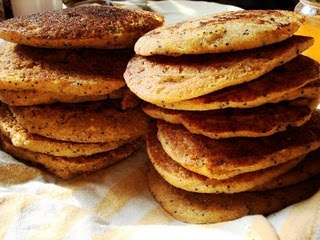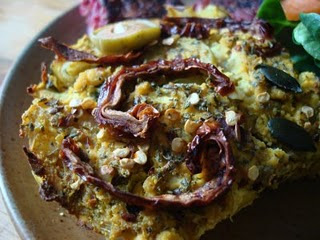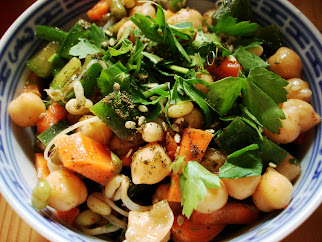African Black-Eyed Banana Muffins
>> Thursday, February 19
 (Silicone muffin cups, oh how i love thee.
(Silicone muffin cups, oh how i love thee.Thine sides are oh so pliable, portable, and never ever stick)
“Never?” My mom’s voice is audibly incredulous.
“Nope.”
“We ate ‘em every new years when I was growing up, it’s a southern thing I guess…”
Well, that’s what happens when southerners move northwest. Rice milk and nutritional yeast take up more and more of their pantry-space. My mom held strong on a lot of southern items, like cast-iron skillets and some epic chilis, but somehow we missed the black-eyed peas.
“Blech, they’re boring.” She adds. Sabotage! With a fresh-soaked bowl of black-eyed peas peering quietly up from the table, it sounds like sacrilege to me, and I’m ready to make something decidedly not-boring.
Black eyed peas came to the southern US as a result of slave trade. They originate in Africa, and have been cultivated there for thousands of years, often as a partner crop to millet, because of the nitrogen-fixing qualities of legumes. Light-bulb: Millet. Yum. I just so happen to have recently tried a great recipe form Wild Fermentation for African Millet Porridge. It’s extremely simple. You literally just have to soak some coarsely-ground millet in water overnight to get a week of breakfasts. A theme emerges, yet somehow, beans and millet sounds like just another northern Californian hippie Thanksgiving. There’s gotta be a way to make that more African.
With a little research, I learned a lot about African food. Let me tell you, the things I didn’t know could be the topic of a few massive volumes. The dishes I dug up feature so many great flavor combinations my western palette trembles at the mere mention of: onions and coconut, peppers and banana, beans and sugar, oh yes, talk about bringing down the cultural house! My roommate just bought a bunch of bananas, and we’ve got loads of coconut, creamed and shredded. BAM! We’ve got everything we need for some Congo-cookin’!
Except, sigh, an actual meal idea. Porridge is delicious, but I need something more portable right now. With a full schedule of being extra-house this week, I know I won’t be returning to top off a soup bowl in between yoga and work. It was a tense moment, and I was sure I would have to abandon African Cuisine for the day, until…When you need them, answers come, my friend, and it was something like euphoria when my gaze fell upon my lovely new muffin tray. Fast as you can say “Mom, black-eyed peas are not boring, they are underappreciated and any fan of hand crafts ought to understand that fully!” I was wrapping some paper around a muffin for the road-and my mouth around the second. They’re that good.
African Black-Eyed Banana Muffins
Ingredients (12 muffins; start the day before baking for the long method):
2 1/2 cups millet, coarsely ground (I used a mortar and pestle)
1 1/2 cup cooked black-eyed peas*
2 ripe bananas
¼ cup rice milk or coconut milk
3 tbsp canola oil
2 tsp molasses
2 tbsp creamed coconut
4 tbsp grated coconut (plus 2 tbsp opt. garnish)
pinch of salt
½ tsp cinnamon
½ tsp nutmeg
½ tsp cardamom
3 cloves, ground to powder
¼ tsp cayenne pepper
1/4 tsp black pepper
1/2 cup buckwheat flour**
1 tbsp baking powder
1 dried banana, in 12 short slices-(opt, garnish)
Directions:
- Stir the millet in a large, non-metallic bowl with about 3 cups of water. Let it sit overnight (This aids digestibility and enhances flavor, but you can also cook the millet before using without any soaking)
- Cook the soaked millet mixture, stirring occasionally until the water is absorbed but it is still moist (about 10 minutes)
- Preheat the oven to 350 F (175 C)
- Mash together the millet, beans, and bananas.
- Add the wet ingredients, except milk, and combine well.
- Add the dry ingredients and check the consistency. It should slowly drop off a spoon, but be thick. Add just enough milk to get the consistency you want, and spoon into your muffin tray
- Garnish each with a sprinkle of coconut and a slice of banana.
- Bake for about 30 minutes, until browned on top and coming away from the sides. They will still be fairly moist. remove them from the tray after a few minutes of cooling, and let them finish cooling on a rack to prevent soggy bottoms. Enjoy with molasses, curry, or with a savory dish of steamed dark greens. They go sweet, sour, or salty as you please!
Notes:
*If you are cooking dry black-eyed peas, soak them in a separate bowl at the same time you start the millet soaking. Then, cook them for an hour or until tender before you begin the recipe.
**You could definitely up the millet and grind it a little better and not include any buckwheat if you want.
If you share my excitement for new and intriguing foreign flavors, check out this great African food site, Africa Cookbook from UPenn, especially this recipe for Akara, which helped give me the idea for my muffins
By the way, did I mention these are an AMAZING nutrient source? THEY ARE.









2 comments:
What a cool idea! They sound super healthy too.
As far as the millet porridge idea: once you soak the coarsely ground millet overnight -- it's good to eat without cooking? Or should you cook it first?
You still have to cook the soaked millet, but it will be much faster and get a nice hot cereal kind of consistency. Bacteria are helping to "digest" it as it sits out and the result is a nice tangy flavor which is great with fruit or with savory stuff (yogurt and garlic are mmmm-ilicious :)). You can make a big bowl of it and leave it covered with a cloth on the counter for a week, taking a bowl-full to cook every day. Then the flavor really develops and it becomes something totally unique, and tummy-friendly!
Post a Comment